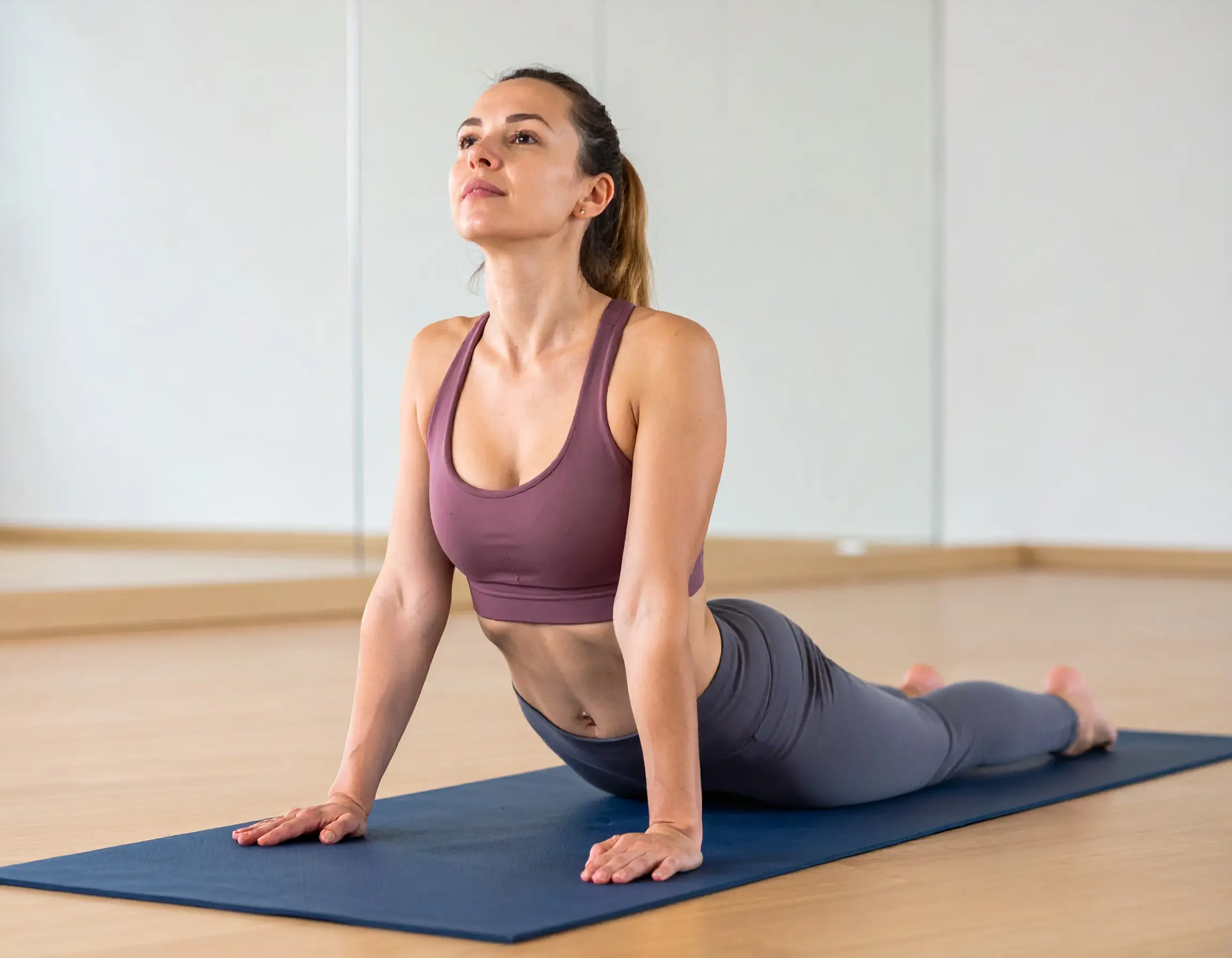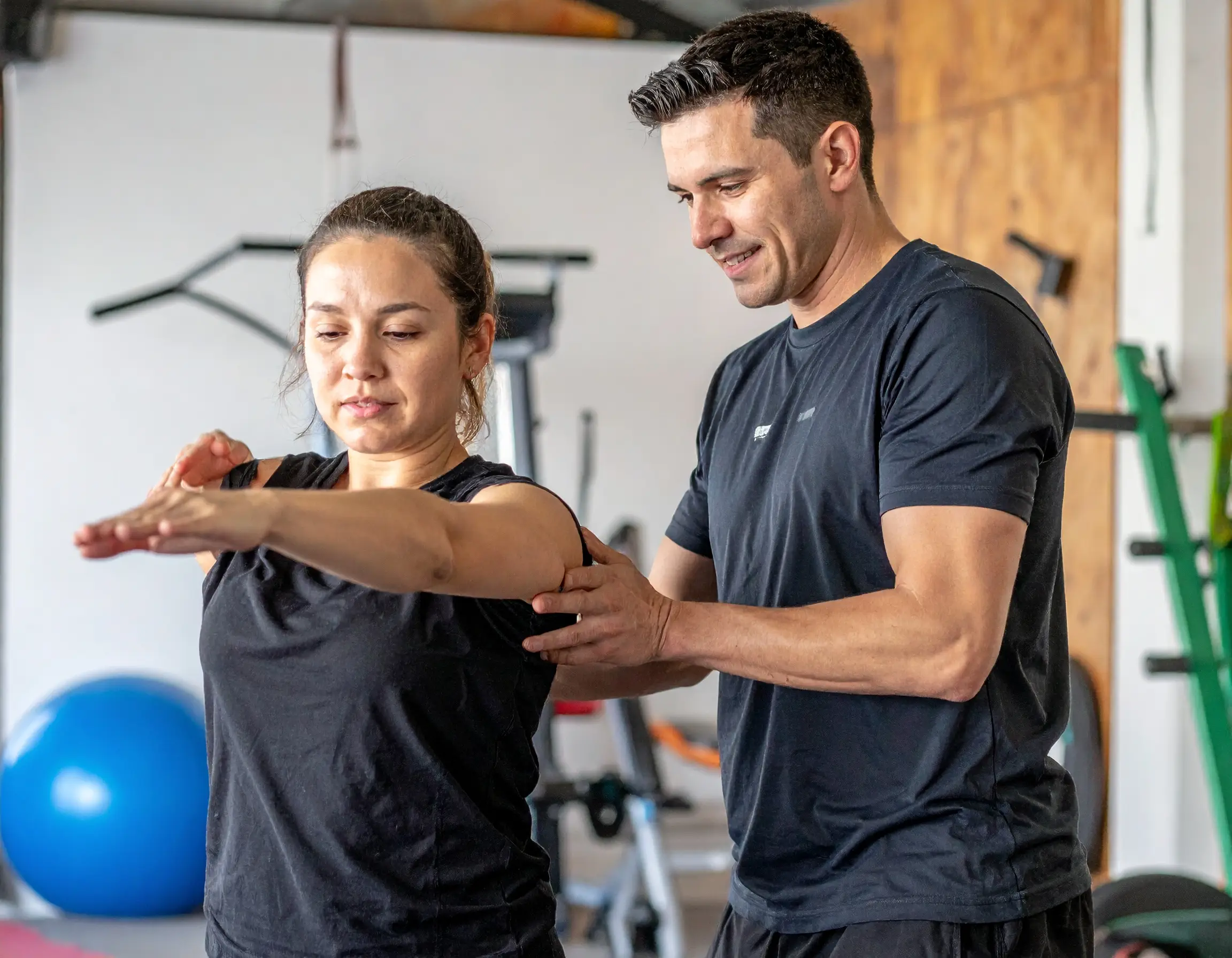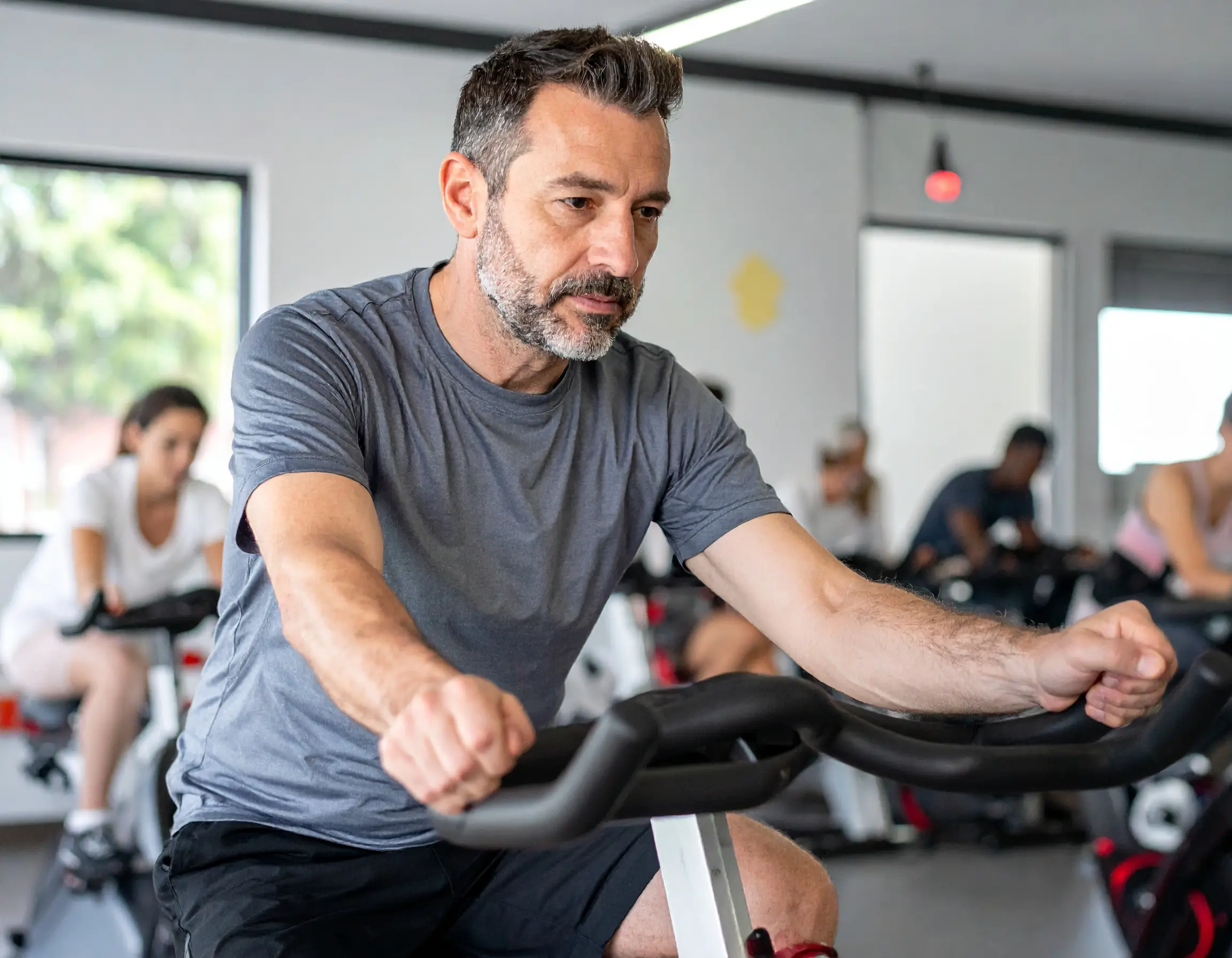Spondylitis and the gym
With spondylitis and the gym, we consider exercise a powerful instrument for symptom control and staying on top of health goals. Routine movement can assist individuals with spondylitis maintain joint flexibility, reduce pain and even elevate mood. We understand that stiff joints can bog you down, so a wise gym regime can keep you moving more freely and living more comfortably.
The right workouts reduce daily stiffness, keep you standing tall, and make picking up that chore or tackling that project at work easier. Low-impact workouts ought to be the core of any gym schedule for spondylitis patients. These types of activities, such as swimming, biking, or walking on a treadmill, are gentle on your joints, but still get your heart pumping. Water aerobics is a solid option as well.
Water removes the weight from your joints as you move. We’ve found that striving for a minimum of 20 minutes of these activities on most days can help with pain and keep you in shape. To most, these moves are easy to initiate, and the consistent tempo helps relax knotted muscles. Strength training is another key piece.
Building muscles around the hips, back, and core to help support the spine and reduce strain on stiff joints is essential. Weak hips, for instance, can sabotage your posture and contribute to pain, so we advise folks to hit the machines, free weights or resistance bands to get those muscles stronger. Two to four sessions a week, keeping the weights light to moderate, is best.
It’s not a pursuit of maxing out, but slow safe incremental gains. Resistance bands, by the way, are great for individuals who prefer less strain but still want to work the muscles that count. Certain gym activities can also directly assist with posture and spinal alignment – both big issues for spondylitis sufferers.
Yoga, Pilates and tai chi classes focus on balance, flexibility and control. They instruct you to employ your body in manners that allow you to stand upright and walk with greater fluidity. These classes are in most gyms and need little gear, making them convenient to plug into your schedule. We recommend starting with beginner classes, so you can learn the moves safely.
Although there’s a lot the gym can do for you, it’s crucial that you heed your body’s signals. Overdoing it can make symptoms flare, so always rest if you ache or tuckered. We do recommend consulting a doctor or physiotherapist prior to starting high-impact sports or making big changes to your routine.
Everyone’s body is unique, and what works for one may not work for another. A well-rounded schedule will blend stretching, strength, cardio and balance work, and you’ll have to experiment.

Listen to your body
When we discuss hitting the gym with spondylitis, it begins with how well we listen to our body. Each session should be dictated by our pain of the moment. If we experience pain during a workout, we reduce the intensity or modify the exercise. What we’ve discovered is that ‘no pain, no gain’ actually doesn’t make you strong – it makes it worse.
For instance, if a chest press sends pain to the upper back, we swap in a lighter resistance band or attempt a different movement, like a seated row. This isn’t about being tough, it’s about being smart. We have to monitor fatigue. Fatigue is normal for those of us with chronic conditions and it’s easy to brush aside when we’re inspired.
When we’re more exhausted than usual, our mission should be to rest and restore, not to drive harder. We take rest days – sometimes even we cut a session short. We remind our clients that recovery is as important as the reps. Skipping a day is not the same as falling behind. Instead, it keeps us from experiencing backlashing.
Stiffness and pain are the warning signs that our body is crying for some variety. If we get up stiff, we begin with light stretching or a hot shower, before making our way to the gym. If something hurts doing a particular exercise, we tweak it. For instance, if standing squats feel bad on the hips, we opt for wall sits or partial squats.
We remind ourselves that every day can feel different, and it’s fine to switch up the schedule last-minute. An optimistic attitude goes a long way, too. Living with spondylitis can make us feel like we’re limited, but we emphasize what we’re capable of. We consider every workout to be a step forward, no matter how slight.
When an exercise doesn’t work, we don’t quit. There are other options. For instance, if treadmill running is too jarring, swimming or cycling could be alternatives. We applaud minor victories, and we don’t berate ourselves for flops.
We still always recommend working with a doctor or a physical therapist. A pro can assist us choose the proper combination of extending, strengthening, and balance workouts. They understand how to identify red flags and recommend adjustments.
We already know from experience that the optimal programs are the ones that suit our physiques – not someone else’s vision of an ideal routine.

Build your support team
Taking the leap to begin a gym routine with spondylitis isn’t simple. We understand that the perfect plan is born from collaborating with the perfect people. Build your support team which makes symptoms easier to manage and helps you maintain a plan that’s safe and effective for you. Each person’s body is unique. That’s why we consistently recommend our clients begin working with a PT.
We assist by establishing a personalized workout routine aligning with your symptoms, objectives, and everyday demands. With spondylitis, there are days that are more difficult than others. Having a therapist who knows what you’re going through allows you to adjust your schedule as needed, instead of pushing yourself needlessly. For example, we may increase stretching and mobility on hard days and add strength work when things are going well.
It’s wise to collaborate with a personal trainer who understands what spondylitis is and how to work around it. We know not all trainers have this experience, so we ensure to match our clients with trainers that do. A quality trainer will demonstrate how to use gym equipment without endangering your joints. They’ll watch your technique, recommend improvements, and ensure safety.
For instance, we frequently find trainers assist with low-impact aerobic work, such as cycling or walking on a treadmill, as opposed to high-impact options that might exacerbate the situation. Sometimes we even see clients join group classes. If you do, inform the instructor of your spondylitis and request modifications for moves that aren’t comfortable.
We never forget the larger care team. That could mean discussions with your doctor, rheumatologist or anyone else in your care team. That way your program aligns with your other treatments, such as medication or surgery schedules. It’s not just about exercise; how that exercise aligns with everything else you’re doing to support your body is crucial.
Family and friends count, too. It’s easy to lose steam when you’re by yourself. I encourage you to call on your inner circle for support – perhaps getting rides to the gym, having someone walk with you, or just checking in. Occasionally family requires additional information regarding spondylitis. We assist by providing them with information, so they learn how to support you optimally without overdoing it.
Others of our clients join support groups or online forums. Other spondylitis sufferers provide you with tips that work in the real world, not just on paper. They share what’s hard, what’s helped, and sometimes simply listen. This makes you less isolated and better equipped to confront the challenges.
It takes time to build this team. You may need to contact them again. It pays. A great crew makes the gym more safe, more enjoyable, and healthier.

Beyond the exercises
Spondylitis living means we have to see health as more than just sets and reps. For most of us, pain and stiffness are details of life. That’s why our habits extend beyond standard gym sessions. Mobility and stretching aren’t just nice add-ons – they actually keep us moving more efficiently and prevent our joints from stiffening.
We emphasize slow, controlled back, hip, and shoulder stretches, holding each for a minimum of 30 seconds a few times a day. This keeps our muscles long and has us standing straighter. For instance, a quick hamstring or chest opener stretch against the wall can go a long way if done daily. We constantly assure one another that it’s fine to take our own rhythm, particularly on rigid days.
Breathing can be difficult with ankylosing spondylitis. Our ribs might not move as much, making us feel breathless. So we employ deep breathing and diaphragm exercises during and outside of workouts. Before we lift or squat, we slow down, taking a few deep breaths with – breath hold of ’03’ – before exhaling fully.
This aids us with more oxygen and keeps our bodies peaceful. Working on our breathing, lying down on our backs with a hand on the belly helps us concentrate on actually moving the diaphragm, not just the chest. Over time, this can relieve tightness and even assist posture.
We too appreciate yoga, particularly gentle classes with an emphasis on mindful, slow movement. Yoga helps us reconnect with our bodies and minds, providing a respite from the stress of chronic pain. During a standard workout, we work through cat-cow, child’s pose and bridge.
These assist in stretching out our spines and opening up our chests. The breathing and relaxation in yoga support our mood and reduce stress. We seek out teachers who understand spondylitis, so they can recommend modifications if we require them.
Keeping active can be about more than just time at the gym. We love to participate in low impact sports such as swimming, cycling or walking in the park. These sports keep us social, which can lift our spirits, and they allow us to move without too much strain.
Low impact are less likely to cause flares. We remind ourselves that even 20 to 30 minutes a day – broken up if necessary – can keep us physically strong and mentally clear. We damn sure aren’t going to let spondylitis keep us from moving, keep us from breathing, keep us from living fully.
Complementary pain management
We understand that life with spondylitis can be one of everyday pain and rigidity. Handling that pain properly is fundamental, if you’re looking to get active in the gym. Complementary pain management is about employing alternative methods – sometimes in conjunction – to help you feel good and move well.
We’ve watched that fitness routines, combined with complementary pain management, can reduce pain and enable AS patients to accomplish more throughout the day. It’s not a cookie cutter approach. Some individuals do well with simple OTC painkillers like NSAIDs for pre- or post-workout soreness.
These can help it easier to get moving, particularly if you rise in the morning stiff or with post-workout pain. It’s wise to consult your physician or pharmacist before taking any new medication, just to steer clear of junk side effects.
For most, massage and acupuncture are nice add-on. Massage can assist in loosening tight muscles, make you feel less stiff and allow you to move more freely. Acupuncture has proven at times to relieve pain and swelling.
We notice individuals attempting it as a supplement, particularly when they’re aiming to minimize their medication dosage. Both are simple to schedule around workouts and you can collaborate with your physiotherapist to determine what works best for you.
Heat/cold therapy is another easy weapon. A warm compress, or hot bath prior to the gym, can help loosen your back and hips. Post-workout, an ice pack can help reduce swelling and soothe tender areas.
These are all at-home things you can do, and they’re safe for most individuals. What helps can vary from day to day – some require more heat, others respond better to cold.
It’s worth discussing more powerful choices with your doctor should you require them. Certain individuals with spondylitis might require corticosteroids or TNF medications to manage pain and inflammation. These treatments can be a huge help, particularly if your symptoms are severe or you’re not finding enough relief elsewhere.
As always, talk to your doctor before modifying your treatment plan. We find that the optimal combination of pain management and movement varies from individual to individual. Some require extra assistance on the job, and others simply want to stay on top of regular activities.
Aerobic, stretching and breathing exercises can be combined to suit your requirements and pain level. Research indicates these customized regimens may reduce suffering and increase your sense of control, but findings are mixed. Long-term studies are still required to find the optimal strategy for all.

Create a sustainable routine
Constructing a sustainable gym schedule when dealing with spondylitis is about more than attendance. We understand the actual benefits stem from your daily actions and how you incorporate movement into your lifestyle. Figuring out a workout schedule that jibes with your daily needs is the first step.
Some of us do best with morning sessions, others post-work. We recommend going small – perhaps just 5 or 10 minutes a day. This allows you to observe how your body reacts without becoming overwhelmed. Over time, these can expand into lengthier periods, but short gets you habitual.
Goals like this keep you honest with yourself and you see the small wins. We don’t need to jump into a marathon or a heavy squat immediately. For others, it might be power walking for 10 minutes with no new pain or hitting a few stretches before turning in each night. Following these targets provides us with a feeling of advancement, which is crucial for drive.
If you skip a day, don’t quit – just try again the following day. We suggest switching up your workouts. The same thing, every day, gets boring and misses other muscles that need work. A balanced schedule incorporates flexibility training, such as easy stretching or yoga, to maintain joint mobility.
Aerobic activities – like walking, cycling, or swimming – increase heart health and stamina. Strength exercises, even with light weights or resistance bands, assist supporting joints and facilitate everyday movement. Throw in some balance work – standing on one leg or gentle tai chi – to stymie those tumbles.
If that feels like too much, chunk movement into smaller bursts throughout your day. A couple five minute walks or stretches really do add up. We cannot emphasize enough how crucial it is to listen to your body. Spondylitis can stiffen and hurt if you overdo it.
If you experience more soreness or fatigue than normal, rest or turn it back. Try daily stretches or range-of-motion exercises to combat stiffness. For others, doing these every morning or before bed works best. Don’t forget, it’s perfectly alright to take a break when necessary! Recovering is the process.
A sustainable routine doesn’t come from brute forcing beyond limits or numbing pain. It’s about discovering what works, aiming for achievable goals, and adjusting as necessary. We’ve found that patience and persistence, not pushing through pain, is what keeps people moving for the long haul.


